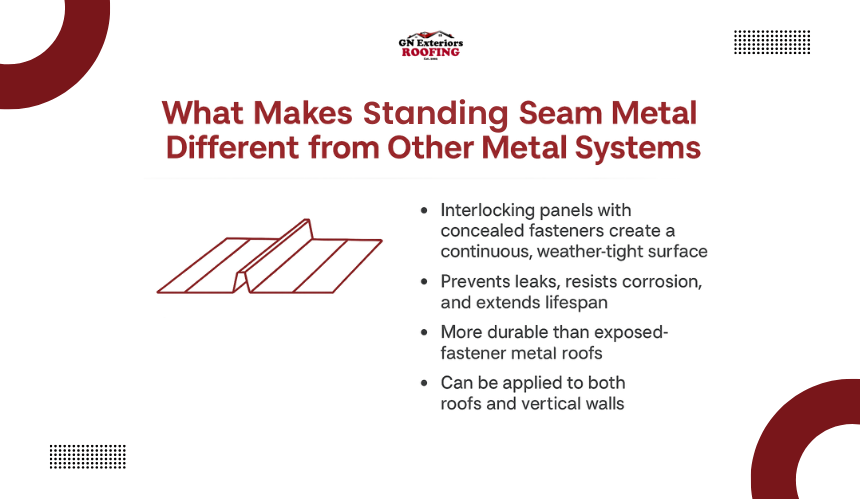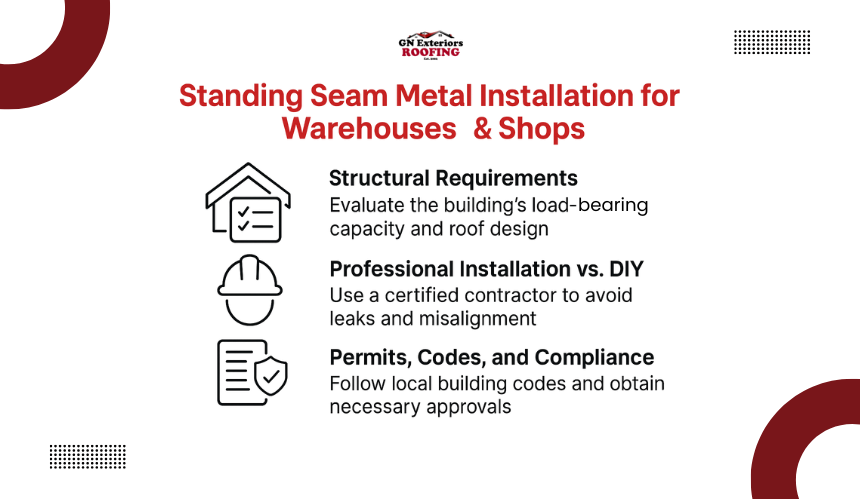
A Quick Answer: Standing seam metal is an ideal choice for warehouses and shops because it combines durability, low maintenance, energy efficiency, and long-term cost savings in a single roofing and wall solution. |
For warehouse and retail property owners, the benefits of standing seam metal roofs extend beyond just protection. Standing seam metal improves operational efficiency by reducing maintenance needs, resisting corrosion, and offering flexible design options that can match a building’s functional and aesthetic requirements.
In this article, we will explore how standing seam metal works, the advantages it offers for commercial properties, installation considerations, environmental performance, and tips for selecting the right system for your warehouse or shop.

Standing seam metal systems use interlocking panels with concealed fasteners, creating a continuous, weather-tight surface. This hidden-fastener design prevents leaks, resists corrosion, and extends the lifespan of roofs and walls, making it more durable than exposed-fastener or traditional metal systems.
The panels can be applied to both roofs and vertical walls, providing versatility for warehouses and retail spaces. Their continuous, flexible design allows for thermal movement and structural stability, ensuring long-term performance with minimal maintenance.

Choosing the right roofing and wall system is critical for commercial properties. Standing seam metal offers unique advantages that directly address the needs of warehouse and retail building owners, from durability to energy efficiency. Understanding these benefits can help decision-makers make informed choices for long-term value and operational performance.
Standing seam metal panels are designed to withstand extreme weather conditions, heavy snow loads, and high winds, making them ideal for industrial and commercial environments.
Their concealed-fastener design protects against mechanical damage and corrosion, ensuring consistent performance over decades. This resilience reduces the likelihood of unexpected repairs, keeping warehouse operations running smoothly.
Unlike traditional roofing systems, standing seam metal requires minimal upkeep. The interlocking panels prevent leaks and eliminate frequent resealing, reducing maintenance costs. Facility managers benefit from fewer service interruptions and lower long-term operational expenses, making it a practical investment for commercial properties.
Many standing seam metal systems include reflective coatings and insulation options that improve energy efficiency, keeping warehouses and shops cooler in summer and warmer in winter. This reduces utility costs and contributes to a more sustainable building footprint, aligning with modern industrial efficiency standards.
Did you know? Studies show that reflective metal roofing can reduce commercial building energy costs by 10–25%, depending on insulation and coating, making standing seam panels a smart choice for energy-conscious warehouses and shops. |
Standing seam metal is naturally fire-resistant and often meets fire rating standards. According to the National Fire Protection Association (NFPA), metal roofing systems have a Class A fire rating, the highest available, which can lower insurance premiums and improve safety for commercial properties.
This feature provides added protection for warehouses storing flammable materials and ensures compliance with safety regulations, a critical consideration for commercial property owners.
Beyond functionality, standing seam metal panels offer sleek, professional aesthetics with a variety of colors, finishes, and profiles. Retail shops can achieve a modern look that reflects brand identity, while warehouses benefit from a clean, professional exterior without compromising durability.

Selecting standing seam metal is only part of the equation. Proper installation is critical to ensure performance, durability, and long-term value for commercial buildings. Warehouse and shop owners must consider structural requirements, professional expertise, and compliance factors before installation begins.
The building must support the weight and design of the standing seam system. This includes checking roof pitch, load-bearing capacity, and framing stability. Proper site preparation ensures panels are installed securely and function correctly under weather and operational stress.
While some metal panels might appear straightforward to install, standing seam systems require a certified metal roofing contractor, experienced with interlocking panels and concealed fasteners. Professional installation minimizes risks of leaks, panel misalignment, and warranty issues.
Local building codes and fire regulations often govern commercial roofing installations. Ensuring compliance with UL ratings, ASTM standards, and local inspection requirements prevents costly penalties and ensures the building meets safety and durability standards.
In Massachusetts, commercial roofing projects must follow the Massachusetts State Building Code (780 CMR), which includes specific requirements for structural integrity, roof loads, and fire safety.

Standing seam metal panels are a long-term investment for warehouses and shops. While initial costs typically range from $8 to $20 per square foot, their lifespan of upto 70 years (with proper maintenance) years means fewer replacements and lower long-term costs compared to traditional roofing.
Galvanized steel provides strength and affordability, aluminum offers lightweight corrosion resistance, and coated PVDF panels enhance durability while reducing maintenance. The interlocking design with concealed fasteners prevents leaks and corrosion, ensuring the panels maintain performance over decades.
Additional savings come from insurance and energy efficiency. Fire-resistant panels can lower commercial insurance premiums, and reflective coatings with insulation reduce heating and cooling costs, making standing seam panels a cost-effective and reliable choice for warehouses and retail properties over their long lifespan.
Selecting the optimal standing seam metal system involves balancing material, design, and installer expertise to meet the specific needs of a warehouse or retail facility. Making the right choice ensures durability, operational efficiency, and compliance with local building standards. Following are the factors to be considered before choosing the standing seam metal system:
Investing in standing seam metal panels ensures durable, low-maintenance, and energy-efficient protection for your warehouse or shop. Partner with GN Exteriors to explore the best solutions, get a professional assessment, and secure a long-lasting roofing system tailored to your commercial property’s needs.
Yes, many standing seam systems can be installed over structurally sound existing roofs, which reduces labor costs and minimizes downtime. However, a professional assessment is necessary to ensure proper support and drainage.
The interlocking design allows panels to expand and contract without damage, making them highly resilient in areas prone to vibrations from machinery, industrial activity, or minor seismic events.
Yes, most panels are made from recyclable metals, and energy-efficient coatings reduce heating and cooling needs. Additionally, the long lifespan reduces material waste compared to traditional roofing replacements.
Over 90% of metal used in standing seam panels is recyclable, making it one of the most environmentally friendly roofing options for industrial and retail buildings.
Absolutely. Panels are available in a wide range of colors, coatings, and finishes, allowing warehouses and retail shops to maintain a professional look that aligns with brand identity.
Installation timelines vary based on building size, panel type, and site conditions, but professional contractors typically complete a medium-sized warehouse roof in 1–2 weeks, ensuring minimal disruption to operations.
Yes. When paired with reflective coatings and insulation, panels improve thermal regulation, keeping warehouses cooler in summer and warmer in winter, which enhances employee comfort and reduces energy costs.